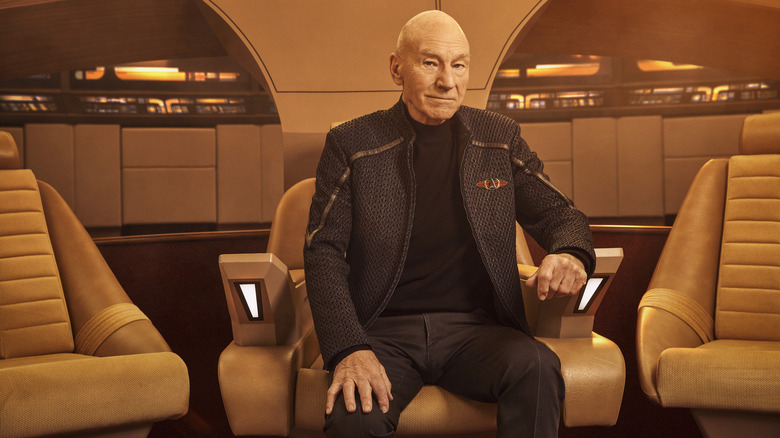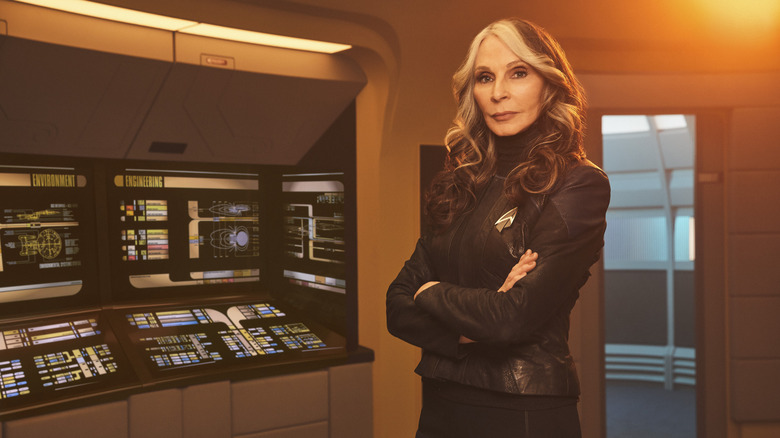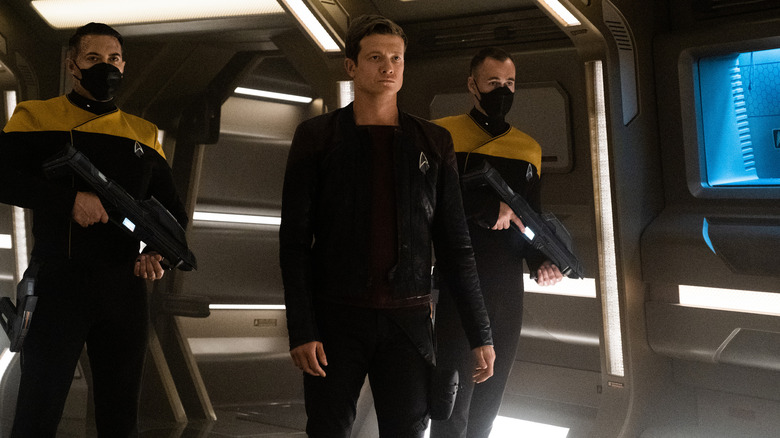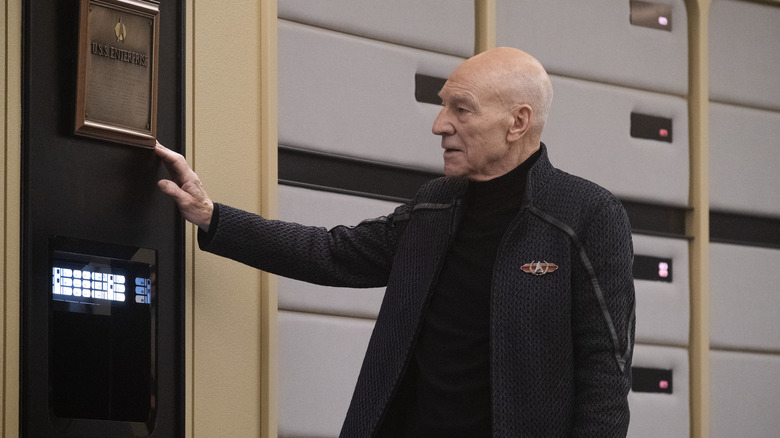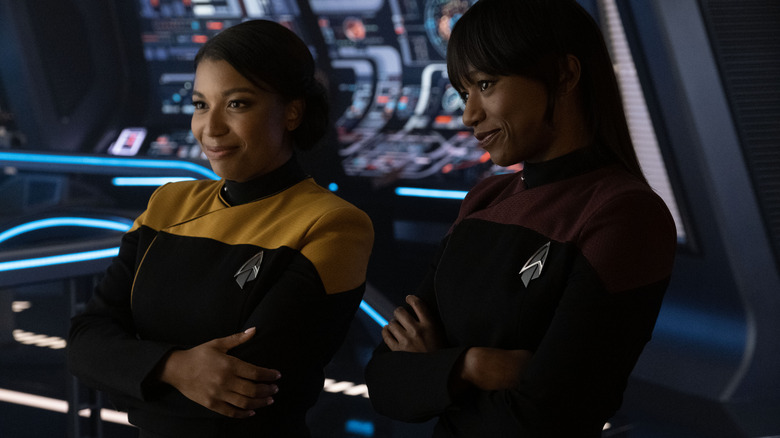Picard Series Finale Ending Explained: Names Mean Almost Everything
At the beginning of the third season of "Star Trek: Picard," the title character (Patrick Stewart) was seen in his French château, packing suitcases of old trinkets and keepsakes, hoping to give them away. He once felt sentimental about such objects, but was determined to leave the past behind. He said out loud that he was not interested in having a legacy, preferring to enter the world and have further adventures. At that point, Picard was over a century old.
Later, Captain Riker (Jonathan Frakes) was enjoying a drink in Guinan's Bar, admiring the trinkets the bartender was selling — or, I suppose, giving away, as "Star Trek" takes place in a post-capitalist society. Bar denizens could take home palm-sized scale models of various famous Starfleet vessels. (Incidentally, the ships on camera are real-life collectibles that one can purchase through the newly launched Master Replicas toy line.) Riker notices Guinan still has multiple models of the Enterprise-D, the ship on which he used to serve. When he asks the bartender why, she tells him it's their least popular model. No one, it seems, wants "the fat ones."
Later still, Riker and Picard tour the U.S.S. Titan-A, a ship once under Riker's command but which had been almost wholly rebuilt. The brusque Captain Shaw (Todd Stashwick) mentions that when he took command, he found Riker's old jazz collection on the ship's computers. Hating jazz, Shaw deleted the entire thing. Shaw then sends Picard and Riker to sleep on uncomfortable bunks typically reserved for younger officers. No one cares, old man.
Moving back into the past
"Picard" season 3 seemed to be setting up a world where nostalgia didn't exist and no one felt especially sentimental about the past. Instead, it was about moving forward, finding the adventure, and — as it would turn out — relitigating the things that once made Picard happy. Most notably, Picard's relationship with Dr. Crusher (Gates McFadden) was enormously strained. The NextGen crew may reunite eventually, but they wouldn't necessarily like one another.
My above presumptions about the running theme "Picard" is derived from my knowledge of the classic "Star Trek: The Next Generation" writing structure. In many episodes, the show would cold-open with a vignette or scenario unrelated to the main plot. That cold-open would, however, connect in a thematic way to the eventual main thrust of the episode. If, for instance, the episode was about the movement of time, the opening conversation would be about how time seems to move differently when you're bored.
If "Picard" spent so much time establishing that it was to be about the shedding of legacy and the lack of sentimentality about the past, then surely that would be the eventual theme of the season at large. "Star Trek" had seemingly reached a refreshing "let the past die" moment.
But the opposite proved to be true this time.
Star Trek ❤ legacy
One of the final scenes in the last episode of "Picard," called "The Last Generation," saw Jack Crusher (Ed Speleers) wearing a Starfleet uniform, bearing the newly earned rank of ensign. Jack is the son of Admiral Picard and Dr. Crusher, and Jack himself is already a symbol of Picard's personal legacy, this time as a parent, continuing in a Starfleet trajectory. He mentions he was able to become an ensign after only just one year of Starfleet Academy, a program that usually takes at least four, and thanks nepotism for his expedited graduation. Picard's legacy helped him along.
Jack's first assignment is back on board the U.S.S. Titan-A, the central ship of the series. Only now, for unclear reasons, it has been rechristened. Jack will serve on board the U.S.S. Enterprise-G.
Quite the opposite of eschewing legacy, it seems that "Picard" is wholly obsessed with it.
Indeed, in a post-credits stinger at the end of "The Last Generation," the presumed-dead trickster god Q (John de Lancie) appears to Jack and tells him he will have to take on the brunt of Q's playful trial of humanity's worthiness, a mantle previously held by Picard. That was the premise of the pilot of "Star Trek: The Next Generation." Jack is not just taking on the legacy of in-universe lore, but the legacy of "Star Trek" writers' old ideas. With "Picard," history begins to cycle through itself again.
Hanging the plaque
It's also notable that a great deal of action in the third season of "Star Trek: Picard" is centered on a starship museum. Relics of the past are put on display, and the characters spend a great deal of time wistfully looking over well-known vehicles from old Trek shows and movies. Seven of Nine (Jeri Ryan) ganders at the U.S.S. Voyager. The "Deep Space Nine" theme song plays when they look at the U.S.S. Defiant. Later, it's revealed that Geordi La Forge (LeVar Burton) has been secretly reconstructing the Enterprise-D for decades. It is used as the central attack vehicle in the season's climax. Previously established as unpopular and dismissed as "the fat one," the Enterprise-D also wants to reclaim its legacy. So much for letting go of the past. "Picard" is keen on letting it calcify.
Additionally, it seems the newer generations cannot be trusted. For a great deal of the third season, Jack slowly develops mysterious psychic powers that make him a badass fighting machine, and also allow him to insert his consciousness into the bodies of others.
It was said that Jack's abilities might have been genetically passed on to him from Picard, himself afflicted with a brain ailment, previously thought to be a fatal disease. It turns out, the disease was a Borg gene that didn't assimilate Picard, but left his son vulnerable. Thanks to the machinations of the plot, said Borg gene was spread to anyone under the age of 25. It was only older people on ancient ships that would be permitted to save the day.
The kids aren't all right
Moving past legacy and letting a younger generation take the reins and define themselves is not permitted in "Picard." The young are untrustworthy, vulnerable to corruption, and the people pulling the trigger. It is only by asserting one's established legacy that one can triumph. There is little in the way of balance on "Picard." All the younger people and ships seem to share names with older things. There are three characters named La Forge, and two named Crusher. When Crusher is assimilated by the Borg, he is not given the exact same name as Locutus, Picard's onetime Borg identity, but is instead called Võx, a similar, voice-related name. Even the Borg push forward the notion of legacy. The central battle seems to be who gets to leave their name behind, and not inventing new ones.
Notions of celebrity, of course, have long been a standing element of Star Trek, and tapping into old legacies happens frequently. Heck, look at the 1994 film "Star Trek: Generations," a film that invents multiple strange sci-fi conceits in an effort to get Captain Picard and Captain Kirk (William Shatner) — two characters separated by 80-some years of history — in the same room together. The crew of the Enterprise-D once met Scotty (James Doohan) in an episode appropriately titled "Relics." The characters on Star Trek have studied the history of Star Trek, and recognize the franchise's more popular characters.
But "Picard" is far more direct. In "Picard," the present doesn't just draw from the wisdom and powers of the past, but — for better and for worse — renames itself to match. It seems we'd better make damn sure history doesn't soon forget the name Enterprise.
